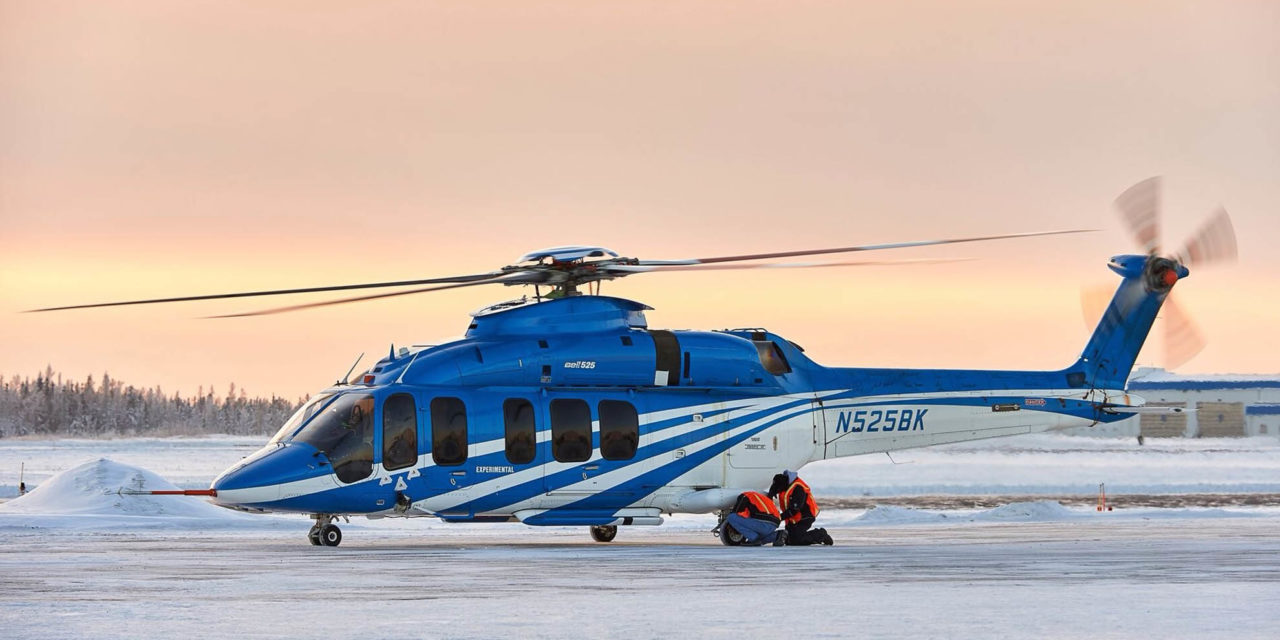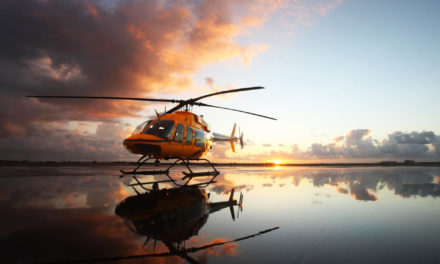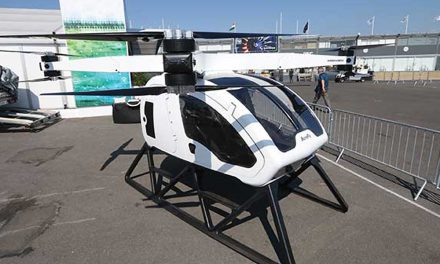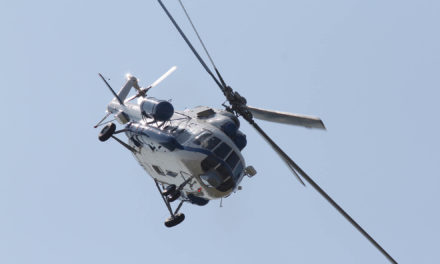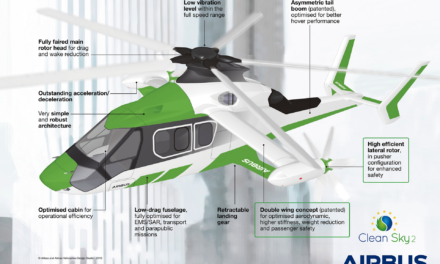In Western Europe, Russia or the United States, many helicopter manufacturers are developing new machines. Helicopter Industry looks over six ongoing programs.
By François Blanc.
At the dawn of 2020, several important programs are being developed. Some, very advanced, will be certified sooner or later. Others, radically innovative, require longer studies and more extensive testing. These are electric flying taxis, whose certification poses unprecedented problems for their designers, whether they are recognized manufacturers or newcomers to the aeronautical sector. The availability of the latest technologies and associated communication tools allows manufacturers to explore multiple solutions that will widen the vertical flight applications.
Heir to proven techniques or, on the contrary, radically innovative, these new machines allow us to glimpse the rotary wing landscape as it could appear on the horizon 2050, without auguring inventions likely to flourish by then.
Kopter’s SH09
Since its creation in 2009, the Swiss company Kopter (called Marenco Swiss Helicopter until January 31, 2018), supported by its shareholder Lynwood (Schweiz) AG, has launched its single-turbine light helicopter program, the SH09. The first prototype (P1) made its first flight on October 4, 2014, the second (P2) on October 5, 2016, and the third (P3) on November 22, 2018.
In the meantime, on February 21, 2018, the company obtained the Design Organization Approval (DOA) from the European Aviation Safety Agency (EASA).
The first two machines validated the concept, gradually opened the flight envelope and confirmed the technical choices, in particular on the dynamic parts. The prototypes P1 and P2 are now grounded, and the third prototype ensures the transition with the two pre-series aircraft, PS4 and PS5, under construction. “The P3 is used as an integrated flying test bench to check the modifications made after the first tests, mainly on the fuselage architecture, aerodynamics, and flight controls. It is the result of research to improve performance, production and maintenance, says Andreas Löwenstein, CEO of Kopter. It will freeze the configuration of SH09, just before the arrival of the two pre-production aircraft that will be used for certification. “
Kopter selected the SH09 single-turbine formula based on the following observation: “No aircraft is pulling up this market into the future at the time being” notes Andreas Löwenstein. However, to attract these markets, including in Europe, the level of safety provided to operators by the SH09 is the priority axis on which the company works. Technical solutions must go “beyond regulatory requirements” and give to the SH09 “the safety level of a twin engine”, particularly in terms of “lightning and electromagnetic fields resistance. “
Operational capabilities and costs constitute the second and third strong points of the project.
To date, Kopter has registered some 70 firm orders and received around 100 letters of intent. Certification is expected “by the end of 2020, at the latest in early 2021.”
Russian Helicopters VRT 500
In spring 2019, during design week in Milan, Italy, Russian Helicopters presented a model of its most recent industrial project: the versatile single-turbine helicopter VRT 500. The current design studies should be completed by the end of 2021, the date on which serial production of the first aircraft will begin at the Ulan-Ude industrial site, in the far south-east of Russia.
During this first exhibition in the West, Alexander Okhonko, managing director of VR-Technologies (the research and design office created by Russian Helicopters in 2014), declared that the VRT 500 would be the first aircraft of the Russian Helicopters range intended for the light monoturbine market. With a maximum takeoff weight of 1,600 kg, it will be able to carry five passengers at a speed of 250 km / h over a distance of 860 km. It will be equipped with two counter-rotating coaxial rotors, according to a formula dear to Kamov, another component of the Russian Helicopters group.
Certification of the VRT 500 by the European Aviation Safety Agency (EASA) is expected to allow it to make a commercial career in Western Europe.
At the Moscow Aerospace Show (MAKS 2019), VR-Technologies signed a marketing agreement with the Malaysian company Ludev Aviation, responsible for selling the VRT 500 on its regional market from 2023.
Finally, in November 2019 at the Dubai International Air Show, VR-Technologies announced that the VRT 500 would be equipped with the PW207V turbine from Pratt & Whitney, derived from the PW200 engine family. This choice should facilitate the certification and maintenance of the new helicopter and have a positive impact on future buyers. Russian Helicopters is planning a first flight of the VRT 500 sometime in 2020.
Airbus Helicopters H160
Eight years after its official launch in November 2011, the Airbus Helicopters H160 is in short final for certification. This medium tonnage twin-engined aircraft fits in the 4.5 to 6.5 ton machine segment. Intended to replace the Dauphin type helicopters in the range of the European manufacturer, it also inaugurates a new industrial production process implemented by Airbus.
In March 2015, during the American Heli-Expo organized by the HAI (Helicopter Association International), a model of the H160 revealed its final shape.
The PT1 prototype first flew on June 13, 2015. The second prototype, PT2, was used on December 18, 2015 to test the first start on a H160 of the new Safran Helicopter Engines Arrano 1A engine. The helicopter manufacturer then planned a first delivery in 2019, a goal it could not keep.
During Heli-Expo 2018, Airbus Helicopters reported that Babcock was becoming the H160 world launch customer.
An EMS (Emergency Medical Services) version of the cabin of the H160, produced by Metro Aviation, was presented at Heli-Expo 2019.
The H160 has a payload of 2,000 kg and can carry 12 passengers. At an economic cruising speed of 255 km / h, it can cross 880 km (or fly for 4 hours 30 minutes without additional tanks, i.e. with 1120 kg of fuel).
Designed to provide great versatility and reduced operating costs, it incorporates innovative solutions, such as the Blue Edge main rotor blades, with low noise footprint, the carbon fiber-based composite materials of the airframe, or the upgraded anti-torque rotor (Fenestron).
With the H160, Airbus Helicopters intends to regain market share in a segment where the manufacturer has declined over the past two decades. H160 certification and first deliveries are expected in 2020.
The Bell 525 “Relentless”
The American manufacturer Bell’s project to design, develop and produce a 9-ton class helicopter, with significant technical innovations, was unveiled in 2012.
At the time, the most promising market for this type of helicopter was the oil & gas market. Since then, the situation has changed. The decline in oil extraction activity has led the American helicopter manufacturer to extend the potential versatility of the aircraft towards other sectors, such as VIP transport, Emergency Medical Services, or firefighting, without completely giving up on the first.
The maiden flight of the first prototype FTV # 1 (for Flight Test Vehicle n ° 1), initially planned for 2014, took place on July 1, 2015. With a full composite materials-made airframe, fly-by-wire controls combined with a next generation digital instrumentation, the Bell 525 “Relentless” represents a global technological advance that no current civilian helicopter can claim.
The accident occured on July 6, 2016 during a test flight, in which the crew lost their lives, resulted in the near destruction of FTV # 1 and the logical suspension of the flight test campaign. Ground testing has continued, pending the results of the National Transportation Safety Board (NTSB) technical investigation.
A year later, test flights are again authorized by the NTSB, pending its final report which was released on January 9, 2018, with new safety instructions. The NTSB attributed the accident to a destructive vibration phenomenon, the main rotor having struck the rear beam, and resulting in the total loss of control of the helicopter. The Federal Aviation Administration (FAA) authorizes Bell to resume experimental development of the 525.
In September 2016, Bell was the only helicopter manufacturer to participate in the Monaco Yacht Show. The 525 was displayed there and Bell planned then a certification of the aircraft in 2018, focusing its communication on the high level of new technologies used on the 525 Relentless: fly-by-wire, cockpit equipped with the avionics suite Garmin G5000H, higher useful load than competitors, technical self-diagnostic capability.
At the end of 2019, the test campaign leading to certification continues, without Bell venturing to communicate a date for obtaining the precious document which will pave the way for the first deliveries.
[Box] NH90’s Fly-By-Wire controls
In charge of the French Navy helicopter doctrine and a NH90 pilot, Commander Claude Bédarride answers two questions from Helicopter Industry.
How do the NH90’s fly-by-wire controls (FBW) affect the design and assembly of the aircraft’s components?
In the main lines, the hydraulic pipes is practically replaced by optical fiber. At the input, signal generators are placed, and at the output, computers process these signals and transform them into hydraulic energy through “drawers”. Only the connection is different compared to a conventional helicopter. However, there is a minimum of hydraulic circuits to transmit the required high pressure.
From the NH90 operator point of view, what operational advantages does the French Navy, derive from FBW?
The Navy, at one point, expressed certain technical and operational needs. However, it was not involved in the development of the NH90. On the other hand, to justify all or part of the technical choices decided by the manufacturer, it is understood that FBW involve greater integration of the system from the design of the helicopter, which itself guarantees greater maneuverability and autopilot optimization. As for the weight saving that is sometimes discussed, let’s stay measured: the French Navy version has a maximum take off weight of 11 tonnes. A few hundred pounds saved are welcome, when they bring a few tens of additional minutes of flight. However, it is difficult to say that the overall ratio is significant. But during hard operations, exposing less pipes to enemy fire helps minimize the risk of hydraulic leaks.
Volocopter
Born in the minds of its designers in April 2010, studied as an industrializable concept from October 2010, the “Multicopter” of the young German company e-Volo, since then, has crossed several crucial stages. The first flight, in October 2011, lasted 90 seconds. In April 2012, the project team received the Charles Lindbergh Foundation Award, the first of many official recognition.
In July 2012, the “Multicopter” was a popular success at the AirVenture air show in Oshkosh (United States). The attraction for this aircraft cannot be denied The second prototype participates in an unrelenting popular support, all around the world, on the Internet.
In August 2012 the German Ministry of Transport awarded a € 2 million grant to the program. This aid attracts significant partners, such as the two German research centers, confirms the interest of institutional actors in the project, and promotes the continuation of the tests.
In November 2013, the first unmanned flight demonstrated the machine’s dual vocation: a leisure flying machine and a multipurpose aerial work tool. In the fall of 2015, an unmanned flight with a load of 120 kg confirms the progress made.
In September 2019, the German life-saving organization (ADAC) carried out a simulation in real conditions with a Volocopter machine. Other perspectives in ADAC projects could lead to operational use. Numerical simulations of medical missions have also been carried out by the Munich Institute for Emergency Medicine and Medical Management.
In addition to testing and maturing the concept, the company, through partnerships, studies the development of infrastructure to build operational bases right in the heart of several major cities around the world.
In November 2019, Skyports and Volocopter presented technical and architectural solutions in Singapore.
City Airbus
The e-VTOL CityAirbus, an advanced concept of a vertical takeoff aircraft powered by electric power, was born in 2017. Airbus Helicopters explains that the initial objective was to “develop an electric powered demonstrator with eight rotors, capable of vertical and take off landing. It was designed to transport up to four passengers between key points in urban areas, for example from the city center to an airport. “
The project was leaded by a team of around thirty engineers and technicians based in Donauwörth, on the German industrial site of Airbus Helicopters. A long gestation phase preceded the first takeoff, which was carried out on May 1, 2019. The aircraft, on that day, was tied to the ground with safety links . Initial tests were previously carried out at the end of December 2017, starting with the powering up of the electrical system test bench. Less than a year later, on October 25, 2018, the demonstrator was turned on for the first time.
Since the first takeoff, other short lift-ups (with ground attachments) have been performed to “analyze the performance of the propulsion system and flight controls. “
Tests are currently continuing at Donauwörth and at Manching, the Airbus military systems study and test center.
CityAirbus is one among some 200 e-VTOL projects under study or test around the world. It foreshadows a model of unmanned passenger transport aircraft over short distances, of the air taxi type, and whose main market could open up relatively soon in large busy cities.
The CityAirbus will have a range of around 15 minutes, at a maximum speed of around 120 km / h on pre-established air routes.
Each of its eight electric motors (one per rotor) develops a power of 100 kW.

